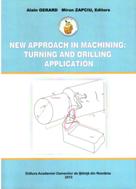 Autori: Alain GERARD, Miron ZAPCIU
Autori: Alain GERARD, Miron ZAPCIU
Anul apariţiei: 2010
Nr. pagini: 190
ISBN: 978-606-92161-8-7
Domeniu: Tehnic (prelucrări metale)
Disponibilitate: La cerere
Citește câteva pagini![]()
Despre carte: Matter removal remains nowadays a major process in the manufacture of objects or structures. Whatever the process of machining used (milling, turning, drilling, etc), the removal of matter is accompanied by translation motion (linear motion) and rotation (circular motion).
Through the principle of the virtual powers, these rotation and translation motions are, mathematically speaking, the dual elements of the forces and the moments. The taking into account of this duality led us not to restrict us with the only concept of force and to hold account in a systematic way of the moments in the manufacture process by matter removal. Thus, it was shown that the taking into account of the forces and the moments, leads to outputs of the machine tools completely comparable with those of the electrical motors traditional (Cahuc et al. 2001; Dargnat et al. 2008).
Considering these results, it is clear that a complete modelling of the matter removal must take into account at the same time the concept of force and that of moment necessarily concerned in these manufacturing processes (Cahuc, 2005). In other words, a real three-dimensional modelling of the materials cut must necessarily call upon the concept of force and moment, or better of torsor, as with the consequences that involves. It is precisely the objective of this book which is based on our work of the last decade with in particular two examples of application which are turning (Part 1) and drilling (Part 2).
Obviously, metrology plays an important role to achieve the goal of a three-dimensional cut modelling. Thus, a large space is reserved to cutting forces. These are acquired by a dynamometer with six components which allow us simultaneously to reach the three components of the forces and the three components of the moments. The torsor concept plays a central role for the continuation of the developments. The translations and rotations are measured in the same way. In the case of turning, in particular, it is established an excellent correlation between efforts (forces and moments) and displacements (translations and rotations).
Thus, this book is structured in two parts. These are independent and classically preceded by an introduction (cf chapter 2). The vector analysis and torsor concept are recalled to the chapter 3. Also, the reader which is familiar to this concept can move on directly to chapter 4. This one relates to the static characterization of a lathe. The concept of torsor appears with small displacements of translation and rotation which leads to its definition, rotation centre and stiffness centre.
The dynamic characterization aspects of the machine tools are the object of chapter 5. Thus, it is given a certain number of recommendations to have the best possible management of the cutting process.
The complete measurement of the tool displacements torsor is the object of the 6th chapter. It is shown that the tool has “on average” an elliptic way located in a tilted plan compared to the machine axes. It is established a correlation between the stiffness centre and the ellipse attached of the tool tip displacements. This ellipse is more or less flattened, according to the rate of vibrations related to the machining process. Thus, the small axis of the ellipse of displacements is characteristic to the rate of vibrations and it is a potential parameter of the surface quality of the machined part. Within the chapter 7 the measurement of the forces and the moments of cut is shown. The moment concept leads to many new results. The link with the displacements torsor is carried out. The meticulous study of the forces torsor is carried out. For the set of tests carried out, the examination of the moments of the forces to the central axis shows a link between the evolution of certain components of the moments and the direction of the chips ejection, for example.
The second part was essentially divided into three stages differentiated and complementary to modelling of the physical phenomena induced by the process of drilling. The first stage (chapter 11) lies in describing the real geometrical parameters according to the parameters of grinding of the tool. While being based on the modelling of the geometry, the experimental cutting model wants to identify the mechanical actions of cutting along the edge (chapter 12). Lastly (chapter 13), the phenomenological aspect of the process, associates the parameters of cut the final quality of the bored holes.